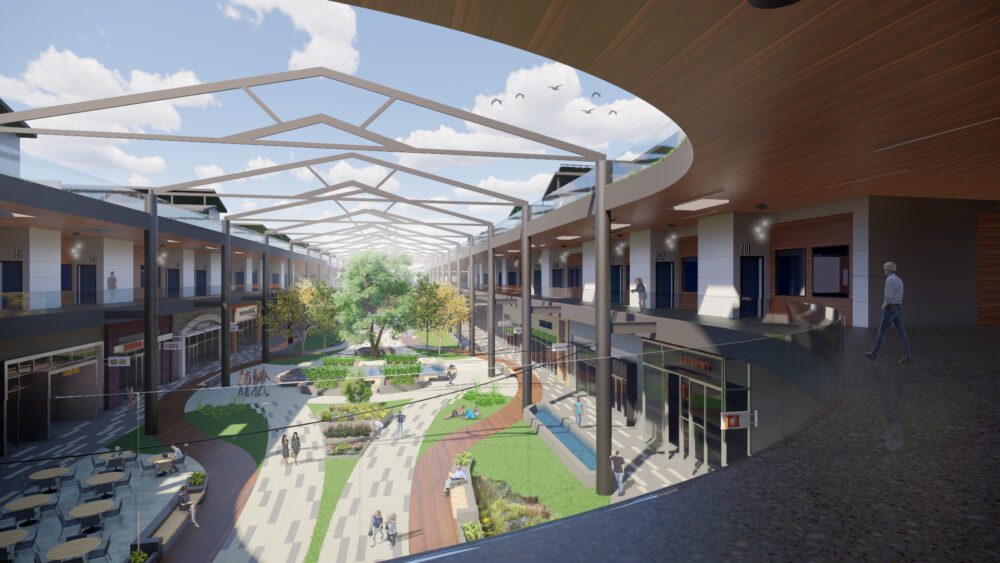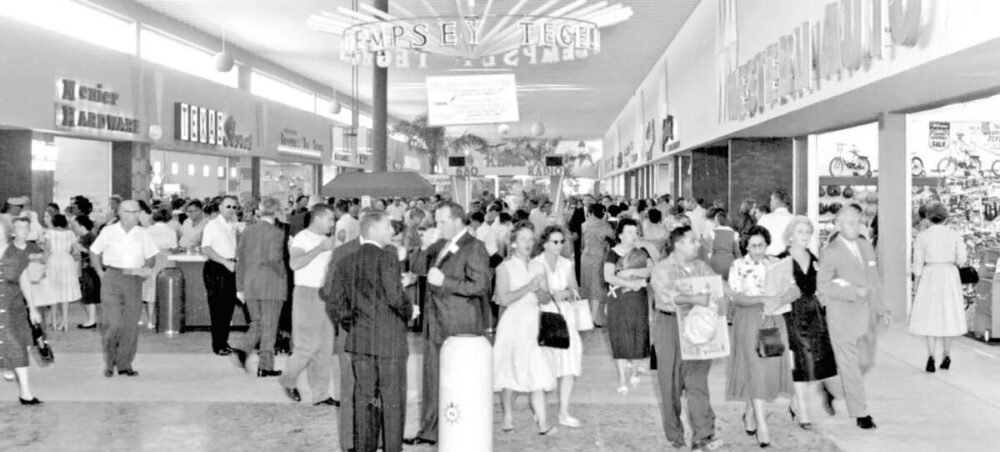
 Interior Courtyard Redevelopment Rendering
Interior Courtyard Redevelopment Rendering
While modern society looks towards the next shiny and new place to be, we often neglect to address our current spaces and how we use them. In an ever-expanding online world, shopping malls have taken a hit. With the effect of the pandemic this past year, the result has meant closures of many retailers. Our team explored concepts for redevelopment of a local mall that has seen better days.
 Current Charlestowne Mall, St. Charles, IL images (Google Images/Flickr)
Current Charlestowne Mall, St. Charles, IL images (Google Images/Flickr)
Charlestowne Mall sits in a well-trafficked, highly visible location in St. Charles, about an hour west of Chicago. But with the decline of retail and use of these spaces, there are ways to leverage current infrastructure that can revive malls like Charlestowne for the better. This design concept addresses the many challenges facing Charlestowne mall and similar suburban shopping centers. Opportunity in the scale and framework of these developments can foster an adaptive reuse approach and provide new ideas for living and working.
The initial idea absolves the single-use of Charlestowne mall by introducing living units and places to work, along with the traditional shopping/entertainment aspects. The design prioritizes greenspace and open air courtyards to both connect the development to the surrounding area and provide ample public and semi-public space.
 Mall Entry / Farmer’s Market above ground-level parking
Mall Entry / Farmer’s Market above ground-level parking
The project has re-organized the former mall into various functions, taking advantage of the multi-level layout with ample atrium/courtyard space. The lower level remains commercial, yet it introduces the idea of more office, work, and creative space to create a sense of community. Similar to malls today, there is an advantage in a large property containing theaters, amphitheaters, and other community based functions. Surrounding the structure is an expansive greenspace that resides over the top of the parking lot(s). The greenspace was envisioned as a way to connect the users of the mall with the outside community while also providing a location for playgrounds, gardens, and even a farmer’s market.
 Natural light fills the space from the front atrium-facing windows, the back patio, and from the light well at the terrace above.
Natural light fills the space from the front atrium-facing windows, the back patio, and from the light well at the terrace above.
Residential units occupy the second floor, giving privacy and a connection to the public functions below. This utilizes the vast roof space, and creates a second residential story that pops up onto the former roof level for many of the units. These dynamic floor plans enhance the livability, increase real estate value, and give the residents a more private ‘yard’ space which would have otherwise been missing in a more urban development. The change to this terrace level also supports passive building strategies like solar and ventilation, reducing the reliance on active systems.
There is opportunity for the residential units to capture the sweet spot between urban and suburban living, which is rapidly gaining popularity and investment in recent years. The spacious, open concepts leverage the high ceilings of the former retail space and allow more flexibility than cramped urban condos, but still benefit from the direct connection to the amenities and community functions within the same development.
 Private Rooftop ‘Yard’ space for residents
Private Rooftop ‘Yard’ space for residents
There is value in looking beyond what shopping malls can be. Through inserting more varied functions such as housing, work/office, and community spaces, they can be revitalized in ways that take full advantage of the existing framework but also address current needs. In the case of Charlestowne and many others, these opportunities already exist. What currently sits with ample unused space can attract new residents and businesses, and more visitors to the new community and destinations as well.
Reinventing the American Mall
 North Star Mall Opening Day 1960 (Express News Archives)
North Star Mall Opening Day 1960 (Express News Archives)
Take a drive down the business highway in most mid-size towns, and odds are that you will inevitably pass by one of the great relics of a bygone era in American culture. The indoor mall was once the epicenter of shopping convenience and consumer capitalism in the 70’s, 80’s, and 90’s. Check out this video of the Richfield Edina shopping mall from 1956 — a flashback to this era and one of the earliest malls in the United States. Southdale 1956 – Richfield Edina Shopping Mall
Today many indoor malls are in a state of suspended animation – a gawky, mammoth lying dormant as the pulse of shopping has run back to main street, lifestyle centers, and of course online retail. Many of the flagship brands that iconized the mall era have long since flown the coop for more lucrative pastures, and the bare bones of what remains – empty shops, food courts, theatres, arcades, plazas, and stalls – sit idly awaiting reinvention.
 Photos of Mall exteriors (Abandoned Mall photos – Seph Lawless/Getty Images)
Photos of Mall exteriors (Abandoned Mall photos – Seph Lawless/Getty Images)
It doesn’t take too much digging to unearth why: simply put, the existing mall format does not meet the more holistic needs of today’s generation. This may be most notable when one compares the typical mall configuration, which relies almost entirely on the foot traffic generated by big-box stores, to the rising trend for more integrated lifestyle design, particularly the “live, work, shop, play” format. When you lump in the growing desire for walkability and sustainable urban design, it becomes very easy to scrutinize the visual, and often visceral, reaction that malls evoke; the far out, windowless behemoth sized complexes, which often float in a sea of parking lots, turn customers away through its lack of appeal and accommodation. In short, if indoor malls want to continue to be relevant, they must confront the changing epoch in front of them and seriously commit to an identity make over.
The paradox is that malls are well-practiced in reinventing themselves. New stores, kiosks, seasonal displays, and even small fast-food retailers flip in and out of plug-and-fill spaces all the time. This highlights one of the great silver-linings for malls looking to adapt: the archetype of mall spaces makes them extremely changeable by design. The more demanding work lies in integrating atypical programs to the standard mall framework, such as housing, entertainment, and recreation. At such a large scale, the role of the designers and architects in this realm cannot be understated; planners and developers must become skilled alchemists who balance the correct blend of programs and utilities to address the morphing needs of future dwellers and patrons, while also keeping costs and existing programs in check.
 Case Study: Stratford Square Mall + Aria Group
Case Study: Stratford Square Mall + Aria Group
At Aria Group, our team approached this endeavor by applying our knowledge and long standing history of experiential design and thinking about how we can alter the framework of malls to meet the needs of today. In particular, our team developed a number of proposed interventions for the Stratford Square Mall in Bloomingdale, IL, which like many malls has shared in the saga of continual decline in recent years. Regarding the strategy for revitalization, Principal Frank Cavanaugh wrote, “ the key strategy we see in giving new life to malls is turning them inside out. Carving out and demolishing underutilized gross leasable area (GLA) to create more elevated exterior tenant visibility and enhanced guest experiences”.
 Proposed Plan Concept- Southwest Entry, Stratford Square Mall
Proposed Plan Concept- Southwest Entry, Stratford Square Mall
This includes introducing lively restaurant concepts that perforate the building’s envelope, especially where they might enrichen existing mall entrances, and adding a mix of other lifestyle businesses like spas, health clubs, grocers, and medical offices. Similarly, exterior spaces and parking lots can be converted to event lawns, seasonal skating rinks, beer gardens, and other mixable entertainment spaces to bring more meaningful and attractive entertainment to the surface of the mall.
 Stratford Square Mall Southwest Entry – Before & After
Stratford Square Mall Southwest Entry – Before & After
The mission to diversify the mall’s retail base goes beyond just a facelift however. The proposition also includes the potential to infuse multi-unit residential and office spaces into the existing complex, turning the typical weekend shopping center into a vibrant community of workers and neighbors. This contemporary pairing of program is akin to the complexion of the traditional town center, where shopping is just an element in the macro-experience of everyday life. In fact, it is precisely the varied assortment of experiences that we believe will make Stratford Square such a desirable place to live, and bring patrons back to visit time and time again.
 Stratford Square Mall – Medical & Residential Site Plan Studies
Stratford Square Mall – Medical & Residential Site Plan Studies
To investigate the potential design possibilities in more depth, Aria Group also conducted a case study of a revival of the Charlestown Mall in St. Charles, Illinois. Check out our next post where we share our exploration into the merger of programs and the spatial opportunities that could re-define the future of America’s malls.








